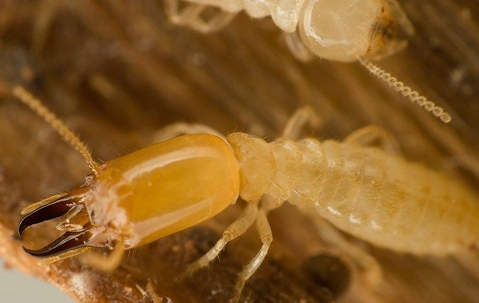In Dallas, we deal with the most destructive type of termite in the United States. It is called the subterranean termite, and it costs U.S. property owners over $5 billion annually. That's more than all other types of termites combined. If you're looking to protect your home from these wood-destroying insects, the first step is to know where to look for termite damage and to familiarize yourself with why they do damage in these places. It all begins with understanding how subterranean termites behave.
Subterranean Termite Behavior
When subterranean termites attack your home, you're not likely to know it. These termites live in the ground and come up from the ground to feed on the wood of your home.
It's difficult to detect termites because subterranean termite workers have an aversion to light. They avoid it at all costs. So they will do their work in dark places or under cover of night. Keep this in mind as we talk about the locations you'll find termite damage.
Furthermore, subterranean termites have thin skin that requires a lot of moisture. For this reason, they stay in the ground or inside the wood they are feeding on. You're not going to see them crawling around on the surface like carpenter ants sometimes will. So the damage they do is usually on the inside of wood, and you won't see outward signs of damage. You may, however, see shelter tubes created by workers to protect themselves from the dry air. Knowing how to recognize shelter tubes is key to detecting termite damage.
What Subterranean Termites Prefer
When subterranean termites attack your home, they're not going to eat every piece of wood they come across. They have a preference for old wood, rotting wood, and damp wood.
There are two things you should understand about this wood preference:
- Subterranean termites will feed on an old fence, deck, shed, and similar "soft targets" before they feed on the sound timbers of your home. They'll also target stumps, logs, firewood, wooden landscape borders, and other untreated and unpainted wood in your yard. The more of this type of wood you have in your yard, the more interesting your property will be to subterranean termites.
- Subterranean termites don't always chew their way into a home. They can exploit entry points that other pests get in through, such as damaged seals on door and window frames, cracks in brick mortar and concrete foundations, and holes created by rodents.
Four Places To Look For Termite Damage
Termites are silent destroyers, and it's hard to tell if they're damaging your home, especially during an early infestation.
Here are some ways to tell you're dealing with an active termite problem:
- If you have a crawl space under your home, it is a good idea to check it routinely. Termites love a dark, moist crawl space. Search for the presence of shelter tubes on your foundation walls or on piers. These tubes may look like mud veins that are the size of a pencil, or they may appear much larger as multiple tubes are created in one spot.
- If water has gotten into your walls and worked its way down to your soleplate, it could have rotted this wood, which is just above your foundation. You'll have to go into your basement or crawlspace to examine your soleplate. Look for shelter tubes and tap on the wood timbers to see if they sound hollow.
- If termites have found an entry point through your foundation wall or through cracked brick mortar, you should see a shelter tube going from the ground to the entry point. A close examination of your entire foundation perimeter can reveal this kind of entry. Look closely between landscaping and your outside walls, and be sure to look under decks, patios, porches, stairwells, and other structures attached to your home. The darker the void underneath, the more suitable it will be for termite workers.
- If you have a structure attached to your home that is old, rotting, or is comprised of unpainted wood, it is likely to be the first point of attack, especially if any of the wood touches the soil. It is at this point of contact that you should look for damage. Termite damage looks like trenches stacked on top of each other. These trenches will be gritty to the touch, unlike carpenter ant trenches and tunneling, which are smooth.
Every home is a little different, and every property has its vulnerabilities. Hopefully, from what you've learned here, you'll be able to have success locating termite activity. But keep in mind that the best way to prevent termite damage is to have a licensed pest control company in Dallas install a termite control barrier around your property. Whether you're dealing with an active infestation or worried about developing one, our team at Addison Pest Control has a solution for you. To learn more about our termite control options, reach out to us today!

